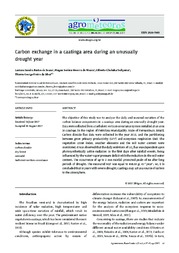Carbon exchange in a Caatinga area during an unusually drought year.
Carbon exchange in a Caatinga area during an unusually drought year.
Author(s): MOURA, M. S. B. de
Summary: The objective of this study was to analyze the daily and seasonal variation of the carbon balance components in a caatinga area during an unusually drought year. Data were collected from a turbulent vortices covariance system installed at an area in Caatinga, in the region of Petrolina Municipality, State of Pernambuco, Brazil. Carbon dioxide flux data were collected in the year 2012, and the partitioning between gross primary productivity (GPP) and ecosystem respiration (Re). The vegetation cover index, weather elements and the soil water content were monitored. It was observed that the daily emissions of CO2 flux was dependent upon photosynthetically active radiation in the first days after rainfall events, being influenced by the water vapor pressure deficit with the reduction in the soil water content. The occurrence of up to 2 mm rainfall promoted peaks of Re after long periods of drought. The measured NEP was equal to 468.18 gC m-2 year-1. So, it is concluded that in years with severe drought, Caatinga may act as a source of carbon to the atmosphere.
Publication year: 2017
Types of publication: Journal article
Unit: Embrapa Semi-arid Region
Observation
Some of Embrapa's publications are published as ePub files. To read them, use or download one of the following free software options to your computer or mobile device. Android: Google Play Books; IOS: iBooks; Windows and Linux: Calibre.
Access other publications
Access the Agricultural Research Database (BDPA) to consult Embrapa's full library collection and records.
Visit Embrapa Bookstore to purchase books and other publications sold by Embrapa.

